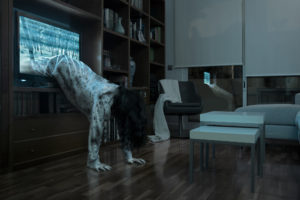In anticipation of Halloween, October is a month full of spooky festivities including scary movies. Gathering a group of friends to watch a horror movie is a fun holiday activity, but finding a movie that appeals to a broad range of people can be challenging. After I watched The Taking of Deborah Logan with some friends, we were evenly split on the number of people who found the movie enjoyable or traumatizing. This made me wonder: why do some people love to be scared, while others hate it?

Fortunately, scientists have investigated how watching movies affects our brains. There is even a name for this branch of studies: neurocinema. In these studies, viewers watch movies while being monitored by functional magnetic resonance imaging (fMRI). Unlike traditional MRI, which generates anatomical images, fMRI measures activity by detecting changes in blood flow. Scientists can use fMRI to study brain activity changes in response to watching a movie because blood flow increases when neurons are activated. In a study by Hasson et al. the authors demonstrated that, compared to unstructured recordings, carefully edited movies can elicit similar patterns of brain activity and eye movement among a variety of viewers. However, horror movies are often carefully planned to shock and terrify so there must be more to people’s preferences than brain activity patterns.
There are multiple theories about why some people enjoy being scared more than others. Some theories suggest the individual differences may be attributed to brain chemistry. For example, fear-seekers may be more sensitive to the rewarding effects of dopamine, a neurotransmitter involved in the flight-or-fight response. A similar, sensation-seeking theory suggests that scary movie enthusiasts enjoy the feelings of heightened stimulation.

To test the sensation-seeking theory, in a study performed by Straube et al., people answered a questionnaire to determine their level of sensation-seeking and then watched scary and neutral scenes from horror movies while being monitored by fMRI. Interestingly, sensation-seekers, or people with high sensation-seeking scores, had lower brain activation while watching neutral scenes. However, sensation seekers had higher brain activity while watching scary scenes than non-sensation seekers. This suggests that sensation-seekers might experience hypoactivation during lower intensity stimulation, such as neutral movie scenes and compensate by seeking more intense stimulation with scary scenes.
So, if you find yourself cringing in horror at the movie selections this Halloween, blame your brain. The good news is there are plenty of light-hearted Halloween options. I personally recommend Young Frankenstein.
Peer edited by Breanna Turman.
Follow us on social media and never miss an article: